
PETA would never approve: This grisly 1840 doll-sized butcher shop with miniature animal carcasses and a floor covered in sawdust and blood would be shockingly graphic to our modern sensibilities. After all, here in the 21st century, we like to remain cheerfully oblivious about where our meat products come from.
But in Victorian times, such detailed model butcher shops were not uncommon, says Sarah Louise Wood, a curator at the Museum of Childhood at the Victoria and Albert Museum in London. The real question is: Why exactly do such things exist?
“It’s a form of escapism into a perfect world.”
One answer can be found in Robert Culff’s 1969 book The World of Toys, which suggests that such playsets—like the ones produced by famous turn-of-the-century toymaker Christian Hacker—did well with Victorian children who weren’t at all squeamish about imagining themselves cleaving a calf’s flank.

Top: An 1840 model butcher shop, pictured in “The World of Toys,” even depicts the blood and sawdust on the floor. Above: The Victoria and Albert Museum has a similar model, circa 1850-’60.
Culff writes that these “exact representations of butchers’ shops” were very popular, “with their modeled joints, strings of sausages, and whole animal carcasses hanging from real iron hooks, tier by tier, ’round the wooden butcher and his two assistants in their striped aprons.” He explains that it must have been satisfying “taking down and wrapping Sunday joints for one’s brothers and sisters, and presumably a certain amount about the prime cuts of meat was learned painlessly in the doing of it.”
But Wood believes that most of the elaborate early 1800s butcher-shop replicas were not intended for children at all. As much as a meter wide, they were more likely created for advertising displays and placed in the real butcher’s window, to let passersby know exactly what the proprietor had inside.

This 1900 model butcher shop, featuring wild boar, however, was made by esteemed German toymaker Christian Hacker and definitely intended for children. From the Victoria and Albert Museum collection.
However, as doll houses—which also started out as toys for adults—were being manufactured for children around the late 19th century, so were small-scale places of commerce, such as the butcher’s. These toy shops allowed kids to mimic adults and learn about money and food, just as supermarket playsets do today. The toy animal flesh, Wood says, wouldn’t have been shocking, because this is how meat was presented and bought and, with limited methods of refrigeration, children would have been used to seeing preserved cuts of meat hanging up.
What we do know is that Victorians documented their entire world in miniature. According to Culff, elaborate and accurate little replicas were modeled for every store in town: the draper, the greengrocer, the fishmonger, the baker, the milliner’s full of bonnets and hat boxes, and the sweet shop featuring “uncertainly balanced scales, jars of hundreds-and-thousands [a.k.a. sprinkles] and cachou lozenges in little tins smelling of ghostly roses and violets.” When you consider this teeny-tiny world it can blow your mind: Can you even imagine sprinkles smaller than sprinkles?

An example of a late 19th-century model grocery store with name-brand products. From “The World of Toys.”
The impulse to miniaturize the world is why we have doll houses in the first place. As it turns out, the earliest doll houses, borne out of “cabinets of curiosity” or “wunderkammers” during the Renaissance, had nothing to do with child’s play, either. At first, wealthy elite collectors would fill their cabinet shelves with miniatures of household finery, and then, the shelves became diminutive models of rooms, thus giving birth to the idea of the “baby house.”
That name means “small house,” but it’s also related to dolls: Starting in the 15th century, beautifully crafted dolls in England were referred to as “babies,” even though they represented full-grown women. The “babies” always wore the finest clothing, made of velvet, silk, and gold lace, patterned on the garments of the aristocratic little girls who loved them.

Miss Miles’ House from 1890 is the only posh Victorian doll house in the Victoria and Albert Museum collection that belonged to an actual child.
Even though girls did have dolls, luxurious baby houses were more often than not the playthings of high-society adults. Duke Albrecht V of Bavaria commissioned the first baby house on record from artisans in Nuremberg, Germany. When it arrived in 1558, he decided it was far too extravagant to be a toy for his daughter.
And no wonder. Owners spared no expense outfitting their baby houses with smaller versions of the most ornate furnishings and elegant accoutrements. Master craftsmen were tasked with making pocket-sized silver, glass, and ivory pieces, and upholstered exotic-wood furniture with working drawers and hinged doors. Accurate petite wool rugs and bedspreads would be woven. Shimmering chandeliers hung from the ceilings, and bronze molds and pans hung in the kitchens.
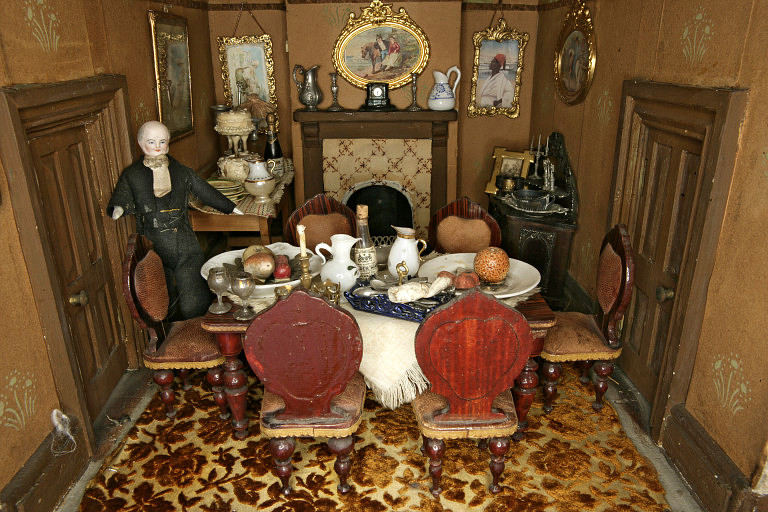
A close-up of the dining room from Amy Miles’ House, shown in full above. From the Victoria and Albert Museum collections.
“It was an expression of wealth,” Wood says. “All of those pieces would have been valuable and showy.“
In the 18th century, top European potteries such as Limoges, Minton, Wedgwood, and Royal Doulton, made doll-house versions of their fine china. British cabinet maker Thomas Chippendale is even believed to have crafted the scaled-down furniture for the 1740 doll house at Nostell Priory. Naturally, if a child were allowed to touch such things, she would be heavily supervised. Wood says that the baby houses might have had a role in teaching children and servants how to inventory household belongings like silver and linens.

The unicorn head right of the door in the 1673 Nuremberg doll house indicates the home belonged to an apothecary. From the Victoria and Albert Museum collection.
Before the Enlightenment, children were mostly regarded as imperfect miniature adults themselves, and they were expected to grow up fast—and start working, studying, or preparing for marriage as soon as possible. Even in the 1800s when the concept of “childhood” was first embraced, many parents considered too much play risky and imprudent. Thus, Victorian children’s books, games, and toys often incorporated moral or religious teaching.
And doll houses were largely the domains of full-grown ladies, well into the Victorian period. In fact, Wood say that of all the Victorian doll houses in the V&A Museum of Childhood collection, only one called Miss Amy Miles’ House, belonged to an actual child. Adult women would delight in picking out wallpaper and furnishings for their doll houses, as friends and family would present them pieces as gifts.

Fine silver, tiny beer steins, and wood furniture in the Nuremberg doll house, pictured in full above. From Victoria and Albert Museum collection.
“Doll-house collectors try to re-create things from their childhoods, or from their imagination, or from history,” Wood says. “It’s a form of escapism into a perfect world where you can control exactly how your house or your shop is set up. It’s almost a feeling of psychological control and retreat that’s less about toys. But children may harness the same thing in imaginative play, too.”
“Toy butcher shops had modeled joints, strings of sausages, and animal carcasses hanging from hooks.”
The same showy Victorian houses may have also been used as instructional toys to teach little girls on how to decorate and maintain an elegant home, although Wood says their specific educational role—versus their decorative one—has varied over time. “But for the most part, doll houses have certainly provided an educative ‘play value’ for adults and children alike.”
It wasn’t until the late 1800s that smaller, less elaborate doll houses were mass-produced exclusively as fun toys for kids by the likes of Hacker, Gottschalk, G&L Lines, and McLoughlin Brothers. And for the first time, commoners, and not just most moneyed members of society, could afford to own them.

The woman who owned the Tate Baby House from 1760 adorned it with the most exquisite decor possible. From the Victoria and Albert Museum collection.
The same companies came out with toy merchant shops, such as the butcher’s, and their corresponding peddler dolls, as toys with an educational slant: to teach little girls how to shop for desirable cuts of beef, lamb, and wild boar. It wasn’t long before these toy stores, like the grocer’s outfitted with tiny tills and weighing scales, were stocked with little cans of Heinz Baked Beans and Fry’s Cocoa, an early example of branding.
As gross as those butcher shops might seem to us now, I remember as a child coveting my best friend’s 1982 Barbie McDonald’s playset, with its beeping cash registers, bitsy serving trays, and fingernail-sized paper hamburger boxes. In 1987, Fisher-Price, too, came out with a far less intricate Little People McDonald’s.

It’s the same cow, ground up and served in little boxes: A 1982 Barbie McDonald’s playset.
In the 19th century, kids were taught how to purchase select cuts from fresh cow carcasses. A hundred years later, they were encouraged to consume overly processed ground beef and trans-fatty French fries from a fast-food behemoth. Which is worse, really?
(Learn more about the history of doll houses and miniatures at the Victoria and Albert Museum of Childhood.)

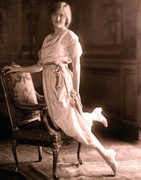 The Reclusive, Doll-Collecting Copper Queen of Fifth Avenue
The Reclusive, Doll-Collecting Copper Queen of Fifth Avenue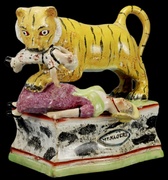
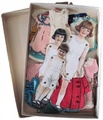 From Little Fanny to Fluffy Ruffles: The Scrappy History of Paper Dolls
From Little Fanny to Fluffy Ruffles: The Scrappy History of Paper Dolls The Reclusive, Doll-Collecting Copper Queen of Fifth Avenue
The Reclusive, Doll-Collecting Copper Queen of Fifth Avenue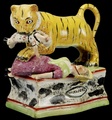 Murder and Mayhem in Miniature: The Lurid Side of Staffordshire Figurines
Murder and Mayhem in Miniature: The Lurid Side of Staffordshire Figurines DollhousesElaborate cabinet-style dollhouses (also spelled as "doll houses"), in whic…
DollhousesElaborate cabinet-style dollhouses (also spelled as "doll houses"), in whic… Dollhouse Furniture and AccessoriesOne of the keys to maintaining the illusion of believability in a dollhouse…
Dollhouse Furniture and AccessoriesOne of the keys to maintaining the illusion of believability in a dollhouse… Mari Tepper: Laying it on the Line
Mari Tepper: Laying it on the Line Nice Ice: Valerie Hammond on the Genteel Charm of Vintage Canadian Costume Jewelry
Nice Ice: Valerie Hammond on the Genteel Charm of Vintage Canadian Costume Jewelry How Jim Heimann Got Crazy for California Architecture
How Jim Heimann Got Crazy for California Architecture Modernist Man: Jock Peters May Be the Most Influential Architect You've Never Heard Of
Modernist Man: Jock Peters May Be the Most Influential Architect You've Never Heard Of Meet Cute: Were Kokeshi Dolls the Models for Hello Kitty, Pokemon, and Be@rbrick?
Meet Cute: Were Kokeshi Dolls the Models for Hello Kitty, Pokemon, and Be@rbrick? When the King of Comedy Posters Set His Surreal Sights on the World of Rock 'n' Roll
When the King of Comedy Posters Set His Surreal Sights on the World of Rock 'n' Roll How One Artist Makes New Art From Old Coloring Books and Found Photos
How One Artist Makes New Art From Old Coloring Books and Found Photos Say Cheese! How Bad Photography Has Changed Our Definition of Good Pictures
Say Cheese! How Bad Photography Has Changed Our Definition of Good Pictures Middle Earthenware: One Family's Quest to Reclaim Its Place in British Pottery History
Middle Earthenware: One Family's Quest to Reclaim Its Place in British Pottery History Fancy Fowl: How an Evil Sea Captain and a Beloved Queen Made the World Crave KFC
Fancy Fowl: How an Evil Sea Captain and a Beloved Queen Made the World Crave KFC
So cool. And I don’t see any difference between this and a toy grocer or kitchen set, or the My Little Pony beauty shop I had. :) I’m sure a lot of kids felt totally comfortable going to see the butcher and had fun pretending to work there.
This is a fascinating and cool piece, but I don’t really see that it was necessary to include the ‘slant’ in the past paragraph; it seems like it was hastily tacked on, and certainly doesn’t reflect an overarching theme of the article, which is considerably more thoughtful than that bizarre ‘social comment’ would have one believe. Many if not most children in late 19th/early 20th century Europe would have been a lot better off if they had access to fast and inexpensive calorie-heavy food like mcdonalds.
Additionally, the claims about the existence (or lack thereof) of childhood in the late medieval period are reductive and inconsistent with modern scholarship. While artistic renderings of children are strangely scaled, they do find plenty of old toys and depictions of children in literature that suggests otherwise.
Cool article, though. I love thinking about the luxury goods industries selling miniatures of their wares; I wish that were still common practice!
Funny – I saw that first one and thought it looked just like The Butcher Shop by Annibale Carracci, circa 1580s.
Why did kids have toy butcher shops? Kids have toy weapons, why not toy meat? Public executions used to be entertainment. It might have given the kid (the butcher’s offsping) an education in the different cuts of meat?
This is very cool!
In our collection we have a Black Forest automata shield clock c. 1840 with a Butcher motif. The Butcher strikes the ox with an ax in sequence to the strike. At the end of the strike sequence the ox falls over dead.
You can see that clock on our “show and tell” page:
http://www.collectorsweekly.com/stories/32090-a-black-forest-butcher-automaton-clock
Best,
Justin
I really enjoyed this article. Plus I appreciate your commentary at the end; I remember having the mini McDonald’s too… As a lover of history this opened my eyes up to something I hadn’t really thought of, but that is impressive nonetheless.
Get toys! Re: Erica: comment #2; it is accurate to refer to the lack of childhood children of the time had. These toys were for the most part preserved because they came from wealthy families. Most of these toys could not be afforded by most people.
We’re fortunate so many good examples still exist. Thanks for the article and photos.
So you think a nicely painted, detailed model of a butcher shop is “grisly”? You should go take a look at where the meat you EAT comes from.
Why would PETA not approve? After all, it is an acronym for People Eating Tasty Animals.
interesting– in the victorian era, no one wanted to talk about sex but they were pretty open about this stuff. i guess the average person was closer to farm roots than we are today.
The miniature pewter pieces are incredible. I once saw some doll china in a similar size that was also in absolutely convincing scale–which thing makes all the difference and is exceedingly hard to find. I know because I’ve been looking.
Erica is correct: McDonalds would have been a vast improvement over the sweetened tea and bread typically consumed by the poor urban children in early 20th century Britain. The problems caused by McDonalds typically don’t manifest themselves before a person reaches the age of 40 and that’s just the age that those children had almost no chance of reaching.
Also: I don’t think there was ever a time up until the second half of the 20th century that butcher shops weren’t positively emblematic of good health. Startling to us these miniatures may be, and for some of you apparently are, but looking for an explanation is ludicrous. The good feeling toward red meat extended even to drinking fresh blood. People continue to eat horse today, and the meat is still scandalously visible in the shops that sell it.
Who is “cheerfully oblivious” about where their food comes from? And if you are, just don’t worry about going to the doctor or exercising, just be “cheerfully oblivious” about how unhealthy you are.
I’m reluctant to disillusion you, but a good butcher shop still has those cuts hanging. However, rather than hanging in the open air covered with flies, they now hang in meat coolers held at certain temperatures that are conducive to aging the meat, especially beef. I can remember delivery day when they brought the sides of beef and carried them into the cooler to hang on hooks for at least a week and this was in the 70s – 1970s not 1870s. They would then break the sides into parts and from these cut the cuts found in the display case. My brother’s shop still does this. But, usually, rather than get whole sides, they get 1/4 sections or the parts and then cut their specialty cuts without so much waste. However, it is getting harder to find butchers that actually know how to break beef and cut it into the parts and then into all the possible cuts for the display case.
I’m here because I was trying to find a Butcher playset for my kid. These Victorian ones would be so cool! I wish they still made toys like this. I come from a long line of butchers and farmers, my kids would love this!
you are truly a excellent webmaster. The site loading pace is incredible.
It kind of feels that you are doing any distinctive trick. Also, The contents
are masterpiece. you’ve done a fantastic job in this matter!